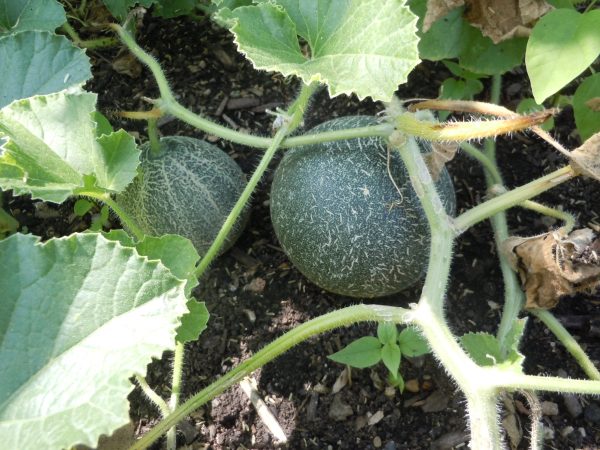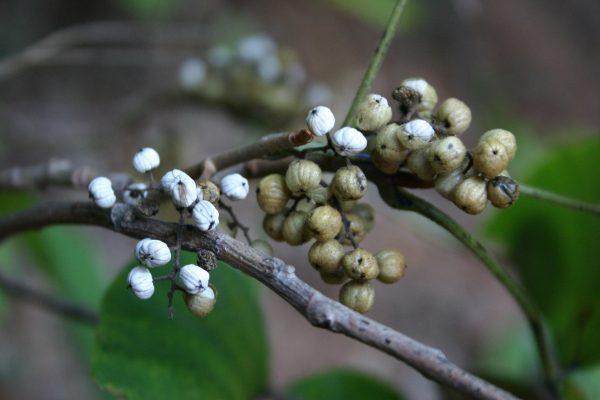Muskmelon

Cucumis melo var. reticulates
Muskmelons are vine crops, closely related to cucumbers, squashes, and pumpkins. These hot-weather plants with sweet, juicy fruit are commonly called cantaloupes, especially the small, smooth, and round ones shipped from the South and available in grocery stores year-round.
• This information can be found in The Georgia Fruit & Vegetable Book by Walter Reeves and Felder Rushing
Actually, cantaloupes are small, hard, and warty fruits common in Europe but rarely seen here in the U.S. Muskmelons, as well as honeydews and Crenshaws-two other summer melons-need a long, hot season to develop. Like most vine crops, muskmelons can occupy a lot of room, which may make you reconsider planting them if yours is a small garden. A way to use less space is to grow them on trellises.
WHEN TO PLANT
Don’t be in a hurry to get muskmelons into the garden very early. They need warm soil (about 70 degrees Fahrenheit or higher) to develop and may rot off if weather is cool and wet. Sow seeds in peat pots indoors under lights a week before the frost-free date (average date of last frost), then set out started plants or sow seed directly in the garden after the latest date of last frost.
WHERE TO PLANT
Muskmelons need a full-sun (8 to 10 hours will suffice) location with well-drained soil and plenty of space. The minimum area required is 25 to 30 square feet per hill. There are alternatives if you have only a small space, however. You may train the vines on a trellis, making sure the structure is strong enough to support the plants; each melon may weigh 2 pounds, and several may develop on a vine. Or you may choose to grow bush types in beds or containers.
HOW TO PLANT
Apply a complete garden fertilizer, such as 10-10-10, at a rate of 11/2 pounds per 100 square feet of garden. Spade or rototill the soil. Sow seeds 1 inch deep in hills about 36 inches apart. In a bed, space them 36 inches apart down the middle. Careful handling is necessary with vine crop transplants because they do not tolerate root injuries common to transplanting. Indoors under lights, sow seeds in peat pots that can be planted without disturbing the roots. Start them about 4 weeks before the latest date of last frost to have large enough plants for setting out. After danger of frost has passed, carefully set 2 or 3 transplant seedlings in hills about 36 inches apart. In a bed, space the plants 36 inches apart down the middle. Set the plants at the same depth they were growing. Melon transplants in peat pots are sometimes available in garden centers at the correct planting time; if you choose to buy them rather than grow your own, be sure that they have a good green color and are free of pests.
CARE AND MAINTENANCE
Water the plants as necessary; they require about 1 inch of water per week. Pests and diseases may affect the plantings. As soon as muskmelon seedlings are planted in the garden, protect them from cucumber beetles. Cucumber beetles not only eat the plants but also infect them with bacterial wilt that will kill the plants about the time they begin to produce fruit. Apply an approved garden insecticide, or use row covers on the plants, being sure to tuck in the edges and ends, to keep the beetles out. After the plants begin to vine, remove the covers, and stop the application of insecticide. Protect the foliage from diseases with an approved garden fungicide. Rotate vine crops to a different part of the garden each year to reduce chances of disease.
ADDITIONAL INFORMATION
Growing melons vertically on a trellis or on a fence requires sturdy supports to bear the weight of the plants with fruits on them. To provide additional support for the heavy fruits, use a little net or a cloth parachute under each melon, tied securely to the trellis or fence. Muskmelons, like all vine crops, have both male and female flowers. The male flowers, which usually appear first, are smaller than the females. Many times new gardeners are dismayed that the flowers fall off without any melons. That usually happens because the flowers are all males. Female flowers have tiny melons below the flowers themselves; male flowers have only slender stems. The flowers are pollinated by bees that feed on the male flowers and then on the females, carrying the pollen from one to the other. Without bees, there will be no melons. If the weather is unfavorable for bees (cold, dark, and wet weather), pollinate the melons by hand by clipping a male flower and dusting pollen from it on the pistils of the female flowers. For the best quality and sweetness, harvest melons when they are ripe. How can you tell when they are ripe? The rind changes from green to tan between the netting, and a ripe melon will smell sweet. Also a small crack will appear next to where the stem is attached when the melon is ready to be picked. Muskmelons do not continue to ripen once they are picked. They will become softer, but not sweeter.
VARIETIES
Varieties
Days to Maturity
Comments
Bush:
Honeybush
80 days
Sweet bush hybrid.
Green:
Jenny Lind
75 days
Heirloom.
Sweet Dream
79 days
Sweet.
Honeydew:
Limelight
96 days
Sweet.
Venus
88 days
Aromatic.
Orange Ambrosia
86 days
Too soft to ship, the sweetest of the muskmelons.
Earlisweet
68 days
Better where season is short.
Harper Hybrid
86 days
Excellent disease resistance; AFPM.
Magnifisweet
85 days
Rivals Ambrosia; FF2.
Saticoy
86 days
FPM.
Supersun
85 days
Large, good flavor.
ABBREVIATIONS FOR DISEASE RESISTANCE:
A=ALTERNARIA, F=FUSARIUM WILT,
F2=FUSARIUM WILT, RACE 2,
PM=POWDERY MILDEW.













